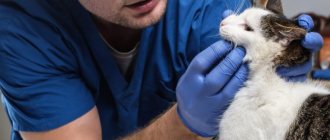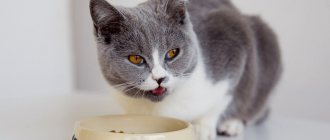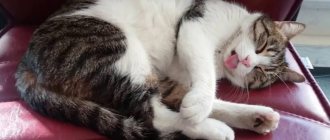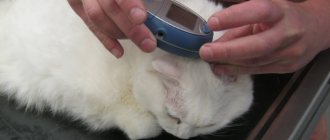While there are many types and colors of coats, your cat's other features are usually more predictable. They will have yellow, green or, rarely, blue eyes, they will have a pink tongue and lips, and their paw pads range from white to pink to brown or black. But what about cats with black lips? Is there something wrong? Are black lips a cause for concern? Why do cats have black lips?
In cats, black lips are a normal part of their coloration. Some cats, especially orange, black and calico cats, are born with black lips. In other cases, your cat may have lentigo.
Don't worry if you notice that your cat's lips are a little darker than usual. In most cases, this coloration is completely normal and healthy for your cat.
Why do some cats have black lips?
Black lips are a genetic trait like any other. It's a slightly rarer color than some alternatives, but your cat's darker lips mean she has a little more melanin in or around her mouth.
Black lips are more common in cats with certain coat colors. This is most noticeable in cats with orange fur, as the black lips stand out against the orange face. However, gray cats with completely black lips have also been reported, as well as calico cats, tortoiseshell cats, and many other colors.
Like melanistic Bengal cats, some animals may also have been bred to stimulate melanin production, which increases the likelihood of black lips.
Although black lips are usually completely normal, sudden changes in the color of your cat's lips may still be a cause for concern.
If your cat's lips were pink and suddenly turned completely black, it may be time to call the vet. Also look for inflammation, decreased appetite or dehydration, discharge or an unusual odor, as these could all be signs that something medical is affecting your cat's lips.
If you are concerned about the color of your cat's lips, your veterinarian will be able to tell you whether you need an appointment or if you can monitor your cat at home.
© shutterstock
Papillomavirus
In kittens under six months of age, dark spots are often found on the tongue and inside of the cheeks, similar to voluminous birthmarks with a flat top. They are called oral papillomas or warts. Such stains should be removed as they can rub and cause pain when fed.
Since these warts can easily be confused with a cancerous tumor, diagnosis and treatment are carried out only under the supervision of a veterinarian. Most often, a course of antiviral drugs, such as interferon, is prescribed. You can also give your pet a special vaccine, with which it will develop lasting immunity to the papilloma virus for a long time. More expensive but effective ways to treat warts are cryotherapy and laser therapy.
Why is a cat's lower lip black?
Over time, the pigment on your cat's body usually shifts and changes slightly. Most of the time, pet owners don't even notice changes in the color or pattern of their cat's coat because they happen slowly. Your cat's bottom lip may also darken as a result of this process.
Most veterinarians agree that changes in your cat's lips over time are not a cause for concern. However, it is still something to keep an eye on if your cat shows any other signs of illness or suddenly changes behavior at the same time.
Generally, a black lower lip is normal. However, if the black color is uneven, you see any discharge, or your cat seems unusually protective of its face or lips, it may be time to take it to the vet.
Fungal diseases
If you notice something black near your cat’s mouth, it is recommended not to self-medicate, but to show the animal to a specialist. After the necessary examinations and bacteriological examination of scrapings or mucous membranes, a fungal infection can be detected.
Despite the fact that ringworm in cats is considered rare, weakened animals may experience this disease. The most common cause is the opportunistic fungus Malassezia. Activation of the growth of this fungus occurs against the background of decreased immunity, so the disease is most often encountered by owners of very young kittens or older animals weakened by a recent illness.
We recommend the article: Albino cats: features of appearance, health and character
The fungus in cats is dangerous because it affects the mucous membranes and ENT organs. Failure to promptly treat the infection can lead to fungal spores affecting the nasal passages or middle ear. Otitis media is the most common complication of fungal infection.
In the initial stages, apart from specific dark spots and crusts, there are no symptoms. A fungal disease detected in a timely manner is quite easy to treat. Therapy is based on treating spots around the mouth with an antiseptic solution and antifungal ointment.
What is feline lentigo
Feline lentigo is a harmless skin condition that causes small black spots to appear on the skin, gums, and even around the eyes and nose. These black patches, also called lentigo simplex, are not a cause for concern if they are flat and have the same texture as the surrounding skin.
Think of these spots as the cat's equivalent of freckles. Your cat will likely develop a few more spots over time, and sometimes the spots may appear suddenly. Some cats will have many lentigo spots, while others will have just one or two.
Unlike freckles, sun exposure is not a direct factor. Your cat is most likely just predisposed to these small spots; it has nothing to do with your care or your cat's environment.
Yesterday
For some reason, some people believe that if a cat has black spots in its mouth, then it has a bad character.
Veterinarians are tired of repeating that the color of a cat’s gums and lips in no way affects their behavior.
Whether with spots or without, a cat can be affectionate and peaceful, or maybe angry and aggressive.
Maybe the reason for the cat’s aggression is not the spotting of the mouth, but something else?
As for the dark spot on the cat’s palate, in 90% of cases it’s just pigmentation. It is safe.
But spots in the mouth (and near the mouth) in cats can be different and have different causes.
The main causes of cat oral pigmentation
Factors influencing spots determine a particular disease.
Acne - blackheads
. Formed around the mouth, lips, chin.
- junk food from the table, lack of vitamins;
- the pet does not wash well;
- stress;
- allergy;
- dirty bowls;
- plastic dishes;
- genetic disease.
Acne does not cause any harm to health, but its appearance does suffer. Almost all causes are easily corrected.
Lentigo
. Can be compared to human freckles. Typically, these are pigment spots on the gums, palate, nose or lips. It is more common in red or spotted cats.
Fungus
. It appears extremely rarely in weakened animals. The spot becomes crusty, dark, and itchy.
Mycoplasmosis
. Pigmentation of the mouth is accompanied by purulent discharge from the nose and inflamed eyes. Cats weakened after operations and serious illnesses are susceptible.
Oncology
. Black spots on the gums and mucous membranes, along with general lethargy and refusal to eat, indicate melanoma. Old cats get sick.
Spots and character
Black spots in a cat's mouth do not always mean a terrible disease. However, it is worth taking your pet to the veterinarian. The specialist will determine the cause and give valuable instructions to the owner on how to care for the cat.
If a cat is not sick and has black spots in its mouth, then why is it angry and disobedient?
Perhaps it's a matter of upbringing? It is important to understand here that you need to accustom your cat to house rules, hands and people from infancy.
As soon as the baby emerges from the nest on shaky legs, education begins!
The kitten must meet its owner. It is very important. The first thing a baby should feel is the affection, kindness and support of a person.
It’s another matter if a teenage kitten was picked up from the street. Tell me how evil he is. Only this is not anger, but protection. Street = survival. And the fact that the kitten survived speaks about his intelligence.
It's easy to judge a cat for his anger and blame it on spots in his mouth. I consider another prejudice to be debunked.
Final thoughts
Changing skin and coat color over time is a normal part of your cat's life. But any sudden change in your cat's coloration can be a cause for concern, especially if it is accompanied by other symptoms at the same time.
Lentigo is not the only skin pigmentation condition in cats. Cats can also get vitiligo, which is almost the opposite of lentigo. Vitiligo causes a lack of melanin in areas of the skin, and in cats, vitiligo can also affect coat color. Typically, vitiligo spreads gradually over time, causing your cat's skin and fur to turn white.
On the other hand, lentigo is usually limited to the skin, meaning that you may only see lentigo in areas where your cat's skin is visible.
Diagnosis and treatment
Although pigmentation in most cases is not dangerous, you should take your pet to the veterinarian. He will establish the exact cause using a visual examination, laboratory tests, and examination of the mucous membrane for bacterial contamination. Treatment:
- With acne, it is enough to get rid of the cause that caused the rash. The animal's condition will return to normal.
- Lentigo is a congenital manifestation, so no treatment is required.
- For fungal diseases, antiseptics are prescribed for rinsing (Stomadex, solutions of Chlorhexidine, hydrogen peroxide, furatsilin) and antifungal agents (potassium iodide, Clotrimazole, Amphotericin).
- Mycoplasmosis - therapy consists of restoring the immune system, giving antibiotics (Ofloxacin, Azithromycin), treating the oral cavity (Ribotan, Cycloferon). Probiotics and Feliferon injections can be prescribed.
- Oncological diseases often remain untreated.
For any reason, it is mandatory to include vitamin-mineral complexes in the diet.
Gingivitis
Gingivitis is an inflammation of the gums in a cat; in the initial stages it occurs as a mild disease. But if you start the process, then not only the superficial layers of gum tissue are affected, but also the deeper ones. Inflammation affects the ligaments that hold the animal’s teeth in the socket, causing them to fall out.
Symptoms:
- Excessive salivation is the very first characteristic sign of the disease; drool is usually viscous and hangs in the form of “icicles”. It is easy to detect in the initial stages of gingivitis in cats and begin treatment on time.
- Swelling – puffiness is a fairly noticeable symptom; the gums begin to “hang” over the teeth.
- Redness – the gums may also have whitish spots or be bluish in color. Upon examination, there will be a bright red stripe on the gums near the base of the teeth. Normally, cats have pale pink oral mucosa.
- Bleeding can be independent and constant, or detected by pressure.
- Strong unpleasant odor from the mouth.
- Severe pain - the cat reacts aggressively to an attempt to examine the mouth, begins to refuse food, and loses weight.
- With ulcerative gingivitis, characteristic ulcers appear on the gums; due to pain, the cat may refuse not only food, but also water.
Treatment:
1. Remove tartar and brush your teeth regularly.
2. Treat the oral cavity with herbal decoctions (oak bark, chamomile) or antiseptic solutions (miramestine, chlorhexidine).
3. Lubricate the gums with dental ointments (Zubastic or Dentavedin).
4. In case of severe inflammation, the veterinarian can prescribe the cat the antimicrobial and antiseptic agent Metrogyl Denta (active ingredients metronidazole benzoate and chlorhexidine gluconate). 5. To speed up the healing of gums, use oil solutions of vitamins A and E, rosehip or sea buckthorn oils, ointments with actovegin or solcoseryl (these substances activate tissue regeneration processes).
Diagnosis by a veterinarian
If the owner notices the warning signs described above, then it is time for an emergency visit to the veterinary clinic. At a doctor's appointment, you need to answer questions about the presence or absence of a pathological desire in your pet to inhale chemicals and washing powder. It is necessary to find out whether he chewed toxic house plants, for example, Kalanchoe, aloe. Explain what was included in the last feeding and what the pet has been doing over the past 24 hours.
The veterinarian may also ask leading questions that may not seem entirely meaningful to the patient’s owner. Most likely, the doctor will ask whether there is air conditioning in the house, when and with what the pet was last bathed. Thanks to questioning, a general picture of the disease emerges, which helps to make the correct diagnosis.
The veterinarian prescribes a PCR test to determine the presence of the virus in the animal’s DNA. Repeated studies are often performed, especially if the results are negative but the symptoms do not subside. If it is not possible to conduct such an analysis, the disease is determined by the clinical picture.
Gangrenous stomatitis in kittens
Kittens and pregnant cats are at risk for stomatitis. Their body is weakened and becomes an easy target for disease. In addition, kittens change teeth, and at the same time, stressful situations, poor nutrition, lack of oral hygiene, lack of calcium and vitamins can lead to serious inflammation of the oral cavity.
Stomatitis in kittens is most often cured quickly, with the help of solutions and antibiotics. It does not progress to the ulcerative or gangrenous stage. When changing teeth, the owner needs to pay close attention to this process, monitoring the appearance of plaque or wounds in the mouth.
Murkoshi specialists note that the pet’s general well-being and its diet also need to be constantly kept in focus.











